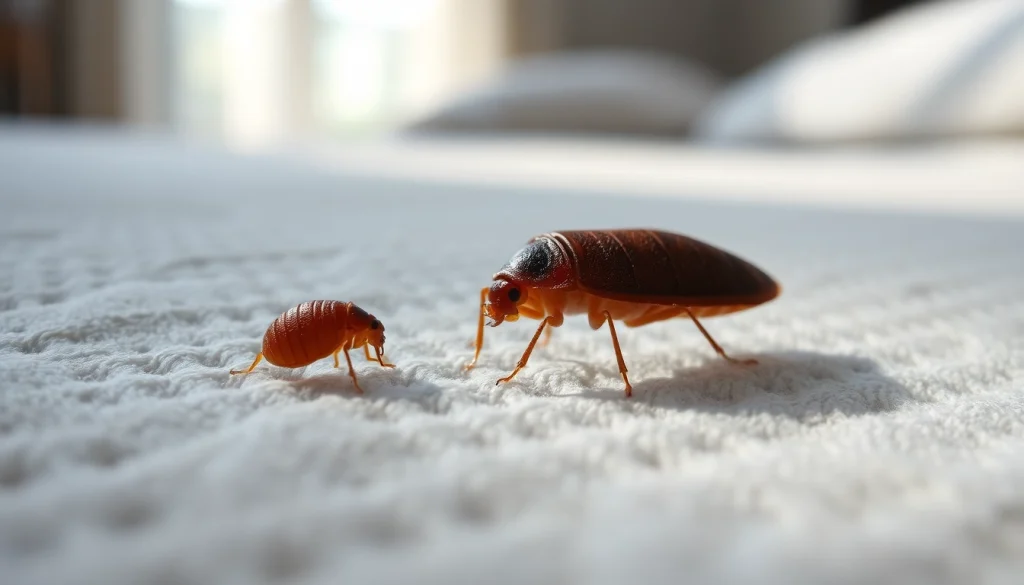
Understanding Bed Bugs
What Are Bed Bugs?
Bed bugs are small, parasitic insects that feed primarily on the blood of humans and animals while they sleep. These nocturnal pests are members of the Cimicidae family, and the most commonly encountered species in homes is Cimex lectularius. Adult bed bugs are about the size of an apple seed, approximately 5 to 7 millimeters in length, and vary in color from brown to red, depending on their feeding status. Their flattened bodies enable them to hide in the most constricted spaces, making them exceptionally adept at evading detection.
Signs of Infestation
Identifying a bed bug infestation early is crucial for effective pest control. Key signs include:
- Visible Bed Bugs: Spotting adult bugs or their molted exoskeletons can confirm their presence.
- Blood Stains: Small brown or red stains on bed linens may indicate bed bug bites or fecal matter.
- Eggs and Eggshells: Tiny white eggs are about 1 millimeter in size and are typically found in crevices or seams of bedding.
- Dark Spots: Excrement typically appears as dark spots on sheets or mattresses.
The Life Cycle of a Bed Bug
Understanding the life cycle of bed bugs is vital for effective control. A bed bug goes through several life stages, including:
- Egg: The female bed bug lays 1 to 5 eggs daily, which hatch in about a week.
- Nymph: After hatching, nymphs go through five stages, requiring a blood meal to molt into the next stage.
- Adult: Bed bugs reach maturity approximately 4 to 5 weeks post-hatching, capable of reproducing shortly thereafter.
Why Bed Bug Pest Control is Essential
Health Risks Associated with Bed Bugs
While bed bugs are not known to transmit diseases, their bites can cause severe skin reactions and psychological effects. Manifestations include:
- Allergic Reactions: Some people can develop severe rashes or skin infections due to scratching.
- Anemia: In instances of numerous bites or extensive feeding, anemia may occur.
- Psychological Impact: Infestations can lead to insomnia, anxiety, and depression due to the stress of dealing with these pests.
The Impact on Quality of Life
Bed bug infestations can severely affect one’s quality of life. Sleep disturbances due to bites can lead to fatigue, decreased productivity, and an overall sense of discomfort in one’s own home. The stigma associated with bed bug infestations may also lead to social isolation.
Economic Costs of Prolonged Infestations
The economic ramifications of a bed bug infestation can be substantial. Factors influencing the costs include:
- Treatment Expenses: Professional extermination services can range from hundreds to thousands of dollars, depending on the size of the infestation.
- Replacement Costs: Furniture, mattresses, and personal items may need to be discarded, adding to the financial burden.
- Loss of Productivity: Time taken off work to deal with an infestation can lead to lost income and potential job stability issues.
DIY Bed Bug Pest Control Techniques
Non-Chemical Methods
For homeowners keen on tackling bed bugs on their own, several non-chemical strategies can be effective:
- Vacuuming: Regular vacuuming of infested areas can help reduce the bed bug population. Be sure to dispose of the vacuum bag or empty the canister outside immediately after use.
- Washing and Drying: Wash all bedding, clothing, and curtains in hot water and dry on high heat to eliminate bed bugs and their eggs.
- Steam Cleaning: High-temperature steam can kill bed bugs on contact. Use a steamer on mattresses, carpets, and upholstered furniture.
Effective Use of Heat Treatment
Heat treatment is a scientifically proven method for killing bed bugs at all life stages. This involves raising the temperature in infested rooms to between 120°F and 140°F. It’s essential to ensure that the heat penetrates all hiding spots, including furniture and wall cavities.
Home Remedies that Work
While many home remedies have been touted for bed bug control, their effectiveness can vary. Options include:
- Diatomaceous Earth: This is a natural powder that can help kill bed bugs by drying out their exoskeleton. Apply it in areas where bed bugs are suspected.
- Essential Oils: Some claim that tea tree oil and lavender oil repel bed bugs; however, these should not be solely relied on for eradication.
Professional Bed Bug Extermination Services
When to Consider Hiring Experts
When an infestation is severe or persistent, enlisting professional pest control services may be the best solution. Consider hiring experts if:
- The infestation has spread beyond control measures you can implement.
- Previous DIY attempts have failed to eradicate the problem.
- There are concerns about health risks or potential damage to property.
What to Expect from a Pest Control Service
When you hire a pest control service, expect a thorough inspection followed by tailored treatment options. Professionals typically outline the process, which may include a combination of chemical treatments, heat applications, and ongoing support to ensure all life stages of the bed bug are eliminated. Proper communication about the methods and safety measures is also essential.
Cost Factors for Professional Treatments
The cost of professional bed bug extermination can vary widely depending on a few factors:
- Severity of Infestation: Larger infestations requiring multiple treatments will incur higher fees.
- Location: Geographic location influences pricing, with metropolitan areas often commanding higher fees.
- Type of Treatment: Chemical methods may be less expensive upfront compared to heat treatments but could require multiple visits.
Preventing Future Bed Bug Infestations
Best Practices for Prevention
Once bed bugs have been eliminated, taking steps to prevent their return is crucial. Effective prevention strategies include:
- Regular Inspections: Conducting routine checks for signs of bed bugs can help catch any re-emergence early.
- Protective Covers: Using mattress and box spring encasements can prevent bed bugs from entering or escaping.
- Be Cautious When Traveling: Inspect hotel rooms and wash clothes immediately upon return from trips.
Regular Inspections: A Key to Early Detection
Routine inspections throughout your residence are vital for early detection of bed bugs. Consider designated areas like bedrooms, living rooms, and even your car, especially if you frequently commute or travel. Early discovery allows for more straightforward resolution.
Creating a Bed Bug-Proof Environment
To establish a more bed bug-proof environment:
- Minimize Clutter: Reducing clutter in your home makes it challenging for bed bugs to find hiding places.
- Seal Entry Points: Ensure that cracks and crevices within your walls and around baseboards are properly sealed.
- Be Mindful of Used Furniture: Exercise caution when bringing used furniture into your home unless it has been thoroughly inspected and treated.
By implementing effective bed bug pest control methods and maintaining vigilant preventative measures, homeowners can protect themselves from these persistent pests and ensure a safe, comfortable living environment.




